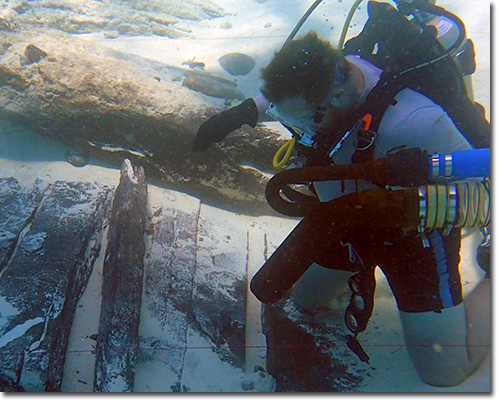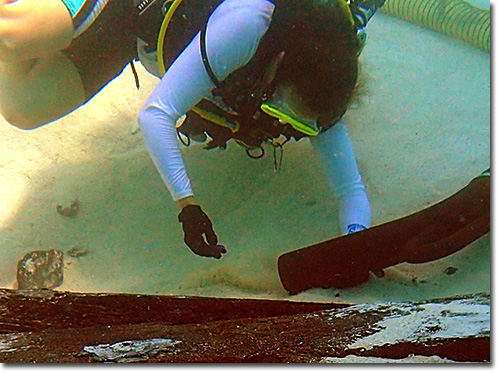The Perils of Dredging By Sean Cox 10 June 2016

Sean Cox dredging in Unit 5 (photo by T. Hough 2016).
The distance from Unit 7 to the eastern-most ballast pile of the Pillar Dollar Wreck is approximately 4 meters. This fact is easy to note, after the incident, because of the many sitemaps we have at the research station. However, at the time of the incident this distance was a more practical concern, as the only thing the sandy bottom of the ocean offered as a means for arresting my flight was the ballast pile. "Ballast is exciting", so it has been said, but it is all the more so when one is traveling toward it uncontrollably.
My means of travel was a shoulder-carried, air-powered jet pack, which had been serving as the dredge for clearing sand from our site, up until the outtake hose blew off. I initially felt pushed face and chest first into the sand, but quickly corrected my position to ill effect, because in doing so I provided the necessary lift needed to act as the wing for my makeshift engine.
Freed of the out-take hose, the dredge carried me south at a rate of some 15 MPH. I traversed the distance from the middle of Unit 7 to the ballast pile in haphazard fashion, heading first due south out the back end of the unit, and then south by west as the dredge corrected course in the current. Had I continued, I believe I could have made it to Havana in about 14 hours, but lacking both wallet and passport, I felt it prudent to arrest my course, and the ballast pile provided me with the only opportunity I was likely to enjoy on the sandy ocean bottom. So I took hold of a larger ballast stone with my right hand and rolled it onto my left, quickly grabbing another to stop my unpredictable careening.
It wasn't until I had stopped moving that I fully understood what had happened. Still in-taking water from the pump on the surface, the dredge bucked in my arms as I look back over my course across the site. Jason Raupp swam for the buoy to signal an emergency cut-off, which was executed almost immediately after being signaled. Then came the work of putting it all back together. Jason brought clamps, the wrench, and the outtake hose, and we worked the hose and the head back together and took extra care that everything was tightly in place. Then, dredging resumed!
Maritime archaeologists make use of dredges to move sand efficiently: hand fanning sand into the dredge head that is then transported to a bag that will catch any potential artifacts that were taken in, enabling their context to be cataloged. It can be slow work, and a fast day, like the one on which this incident occurred, involved moving a lot of sand that had slumped into the excavation.

Sean Cox dredging in Unit 5 (photo by A. Ropp 2016).
My misadventure with the dredge is the second of just two 'perils' that I (now) know to working with the device. Since it is basically a high-powered vacuum cleaner, keeping anything dangling from SCUBA gear is essential to ensuring it doesn't get sucked off one's BCD. The dredge head is metal and that comes with its own discomforts, though a pair of gloves can solve this easily. All of which is to say, when it comes down to it, the only real risk when using the dredge is that it might unexpectedly propel you across an excavation site and into a pile of large rocks. Fortunately for me, it worked out quite well.
Previous Next

